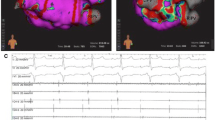Abstract
Transseptal left heart catheterization has been performed as an alternative to the retrograde approach since 1958. However, this procedure can result in life-threatening complications, some of which may occur because of insufficient anatomical landmarks. Accordingly, we sought to assess the safety and efficacy of a new transseptal left heart catheterization technique designed for ablation procedures. Specifically, we examined whether electrode catheters could be used as anatomical landmarks, permitting identification of the aortic root and other critical structures.
Results: One hundred and eight consecutive patients underwent transseptal left heart catheterization under biplane fluoroscopy during catheter ablation. Electrode catheters positioned in the right atrial appendage, His bundle region, and coronary sinus were used as anatomical landmarks to guide the transseptal unit to the fossa ovalis. The angles of the right anterior and left anterior oblique projections were selected in each patient based on the orientation of the His bundle and coronary sinus catheters. Transseptal left heart catheterization was successfully performed in all patients without complications. In contrast to previous reports, the direction of the needle at the successful puncture site in the last 96 patients varied substantially: 2 o'clock in 13 patients (13 %); 3 o'clock in 43 patients (45 %); and 4 o'clock in 40 patients (42 %).
Conclusion: The use of electrode catheters as anatomical landmarks and biplane fluoroscopy facilitates transseptal catheterization. This approach can be used safely during catheter ablation procedures.
Similar content being viewed by others
References
Ross J Jr. Catheterization of the left heart through the interatrial septum. A new technique and its experimental evaluation. Surg Forum1958;9:297-300.
Ross J Jr. Transseptal left heart catheterization: A new method of left atrial puncture. Ann Surg1959;149:395-401.
Brockenbrough EC, Braunwald E. A new technique for left ventricular angiocardiography and transseptal left heart catheterization. Am J Cardiol1960;6:1062-1064.
Gorlin R. A modification of the technique of transseptal catheterization. Am J Cardiol1961;7:580-582.
Mullins CE. Transseptal left heart catheterization: Experience with a new technique in 520 pediatric and adult patients. Pediatr Cardiol1983;4:239-245.
Roelke M, Smith AJ, Palacios IF. The technique and safety of transseptal left heart catheterization: The Massachusetts General Hospital experience with 1279 procedures. Cathet Cardiovasc Diagn1994;32:332-339.
Libanoff AJ, Silver AW. Complications of transseptal left heart catheterization. Am J Cardiol1965;16:390-393.
Jackman WM, Wang XZ, Friday KJ, Roman CA, Moulton KP, Beckman KJ, McClelland JH, Twidale N, Hazlitt HA, Prior MI, Margolis PD, Calame JD, Overholt E, Lazzara R. Catheter ablation of accessory atrioventricular pathways (Wolff-Parkinson-White syndrome) by radiofrequency current. N Engl J Med1991;324:1605-1611.
Jackman WM, Beckman KJ, McClelland JH, Wang X, Friday KJ, Roman CA, Moulton KP, Twidale N, Hazlitt HA, Prior Ml, Oren J, Overholt E, Lazzara R. Treatment of supraventricular tachycardia due to atrioventricular nodal reentry by radiofrequency current ablation of slow-pathway conduction. N Engl J Med1992;327:313-318.
Swartz JF, Tracy CM, Fletcher RD. Radiofrequency endocardial catheter ablation of accessory atrioventricular pathway atrial insertion sites. Circulation1993;87:487-499.
Seifert MJ, Morady F, Calkins HG, Langberg JJ. Aortic leaflet perforation during radiofrequency ablation. Pacing Clin Electrophysiol1991;14:1582-1585.
Minich LL, Snider AR, Dick M 2d. Doppler detection of valvular regurgitation after radiofrequency ablation of accessory connections. Am J Cardiol1992; 70:116-118.
De Ponti R, Zardini M, Storti C, Longobardi M, Salerno-Uriarte JA. Trans-septal catheterization for radiofrequency catheter ablation of cardiac arrhythmias. Results and safety of a simplified method. Eur Heart J1998;19:943-950.
Tucker KJ, Curtis AB, Murphy J, Conti JB, Kazakis DJ, Geiser EA, Conti CR. Transesophageal echocardiographic guidance of transseptal left heart catheterization during radiofrequency ablation of leftsided accessory pathways in humans. Pacing Clin Electrophysiol1996;19:272-281.
Daoud EG, Kalbfleisch SJ, Hummel JD. Intracardiac echocardiography to guide transseptal left heart catheterization for radiofrequency catheter ablation. J Cardiovasc Electrophysiol1999;10:358-363.
Author information
Authors and Affiliations
Rights and permissions
About this article
Cite this article
Gonzalez, M.D., Otomo, K., Shah, N. et al. Transseptal Left Heart Catheterization for Cardiac Ablation Procedures. J Interv Card Electrophysiol 5, 89–95 (2001). https://doi.org/10.1023/A:1009818210563
Published:
Issue Date:
DOI: https://doi.org/10.1023/A:1009818210563




